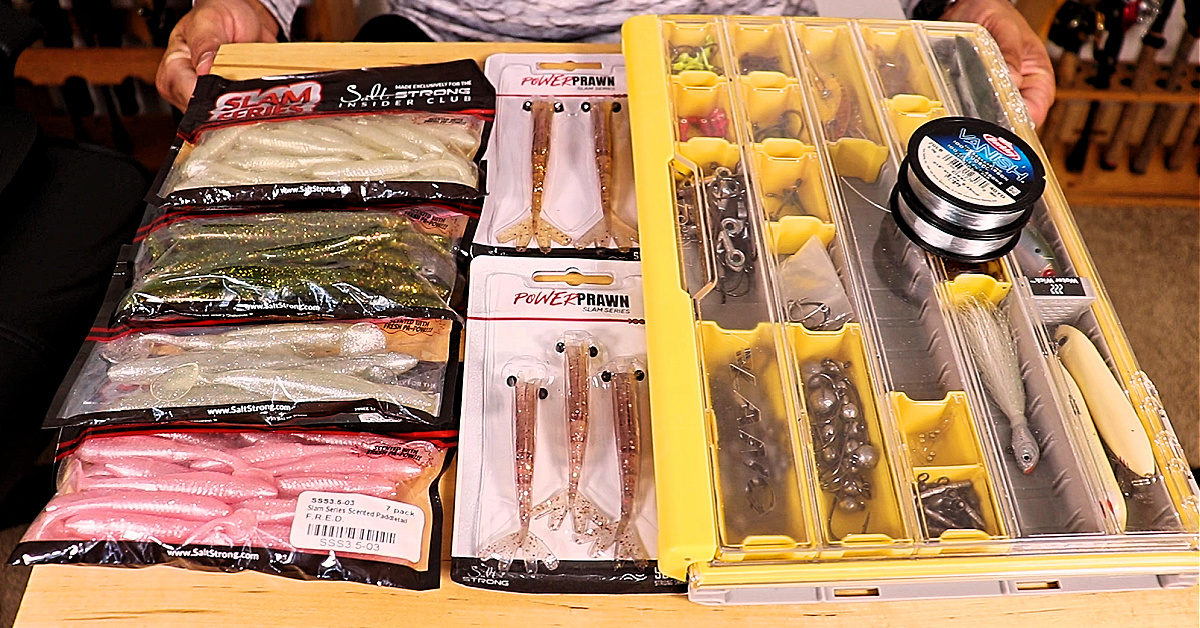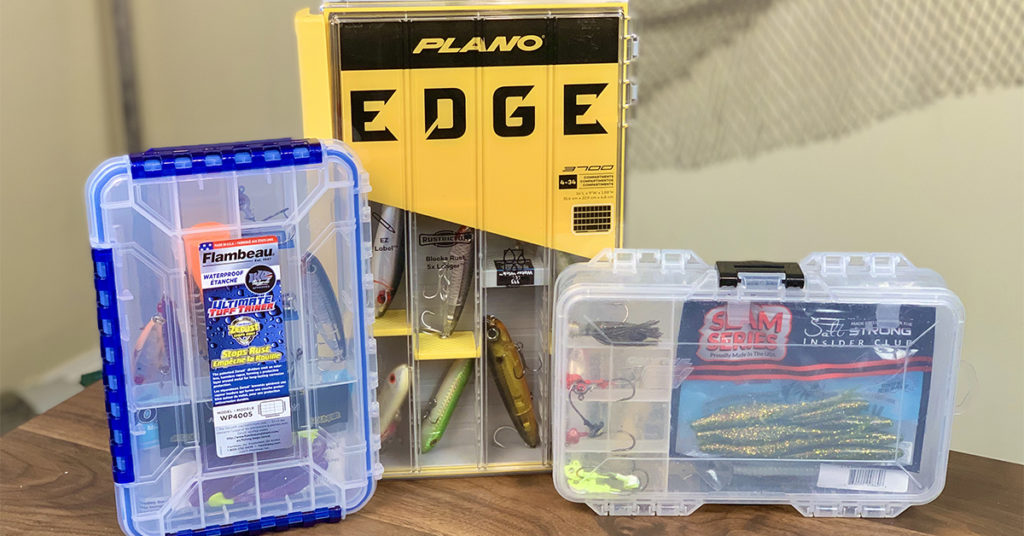What To Bring In Your Tackle Box For Inshore Fishing
- By: Tony Acevedo
- on

Last week we went over Inshore Fishing 101, but what gear do you need for every inshore fishing scenario?
What should your tackle box look like?
In order to successfully inshore fish, you need the right terminal tackle and lures to get strikes and reel in fish!
Check out more below!!!
What To Bring In Your Tackle Box For Inshore Fishing [VIDEO]

Equipment Used:
- Owner Twistlock Hooks (3/0 and 4/0 of 1/16 oz. to 1/4 oz.)
- Trout Eye Jigheads (1/8-1/4 oz.)
- Redfish Eye Jigheads (1/4 oz.)
- Saltwater Assassin Pro Elite Jigheads (1/8 oz.)
- Power Prawn Jigheads (1/8 oz. – 1/2 oz.)
- Battle Rattles
- Swivels
- Berkley Vanish Leader (20# and 30#)
- Plano Edge Terminal Tackle Tray 3700
- Salt Strong Split Ring Pliers/ Braid Scissors
- Dr. Juice Saltwater Slam Scent
- Lures:
Over time, your tackle box will start to become disorganized with tackle and lures mixed together and thrown into open spaces.
It could be gear you don’t even use or need anymore that is still sitting in your tackle box.
If you can simplify your tackle to only necessary items, you will be more successful when inshore fishing.
Plano Edge Terminal Tackle Tray 3700
The Plano Edge Terminal Tackle Tray 3700 has plenty of compartments for both terminal tackle and lures.
A feature of this tackle tray is it comes with little boxes or compartments that seal in your hooks or jigheads and can be removed out of the tray for easier access.
This prevents your hooks and jigheads from sliding around the tackle tray and stops any tackle from getting mixed up.
Also, the Plano Edge Tackle Tray is slim in its design and narrow along the side which makes it easier to store on a kayak, paddlecraft, or a boat.
As a bonus, the tackle tray is waterproof.
Depending on what you prefer to fish with, you may dedicate a lot of the room in the tray to terminal tackle or hard-body lures.
If you use mainly soft plastics, you are going to have to set aside space for terminal tackle.
Soft plastics are more versatile than other lures in that you can cover more ground and more of the water column with them.
Hard-body lures are specific to one use and most of the time you will have to switch out the lure entirely to cover a different depth in the water column.
Some anglers prefer to have separate tackle trays of weights, lures, and terminal tackle, however, it is not necessary.
If you can simplify your tackle and know exactly what you need for any trip you go on, you can fit it all into one tackle tray.
Hooks & Jigheads
You should have various sizes of weighted hooks in your tackle tray.
Owner Weighted Twistlock Hooks ranging from 1/16 oz. to 1/8 oz. are going to prepare you for different situations.
Weedless hooks are perfect if you are fishing shallow water around different types of structures.
After you get your weighted hooks in order, the next most important terminal tackle is your jigheads.
As far as color is concerned for jigheads, plain silver or grey, red, and chartreuse are preferred.
Chartreuse is the color of choice for dirty water because it stands out more.
Red will work in both clear or dirty water and grey is the neutral color that can work under any condition.
The red and chartreuse jigheads are Saltwater Assassin Pro Elite Jigheads weighted 1/8 oz.
Z-Man Trout Eye and Redfish Eye Jigheads are best for the neutral grey color and those should be anywhere from a 1/8 oz. ro a 1/4 oz.
The length of some of the shanks on jigheads also comes into play with larger or smaller soft plastics.
Longer soft plastics are best used on the Redfish Eye Jighead which has a longer shank that the Trout Eye.
Shorter soft plastics will swim better on the smaller Trout Eye Jighead or Swimbait Jighead.
The different weights of the jigheads allow you to cover different depths of the water column.
If you plan on using the Power Prawn Artificial Shrimp lure, you will also need Power Prawn Jigheads.
These jigheads are made exclusively for the Power Prawn and you should have various weights to cover all of the water column.
It is also recommended that you bring along a couple extra single inline hooks for replacements on topwater lures that may bend in a fish’s mouth or rust out.
Fishing Live Bait
If you also plan on mixing in live bait fishing on your trips, it is a good idea to store some circle hooks in your tackle tray.
Anything from a 2/0 to a 5/0 will cover all sizes of bait and prepare you for live bait fishing.
Circle hook sizes are usually determined by the size of the bait you are using.
You should also have some swivels with you if you plan on fishing with live bait.
Swivels are handy if you are fishing with live bait in deep water or water with strong current.
Lures
In your tackle tray, it is a smart idea to always have spoon jigs and lures.
Aqua Dream Gold Spoon of a 1/4 oz. weight is effective for fishing in fall and winter for redfish, snook, and seatrout.
Furthermore, MirroLure MirroDine hard-body lures provide a different presentation from soft plastics and topwater lures.
They come in both light weight and a heavier weighted lure for deeper water columns.
There is also the MirroDine XL which is a bit larger and has a bigger profile compared to the smaller MirroDine.
A must-have essential in your tackle box is a bone-colored topwater lure.
Either the Salt Strong Moonwalker or a Heddon Super Spook Jr. are excellent topwater lures.
Additionally, a bucktail jig never hurts to have in your tackle box.
A bucktail is one of the most universal lures out there that is applicable in any situation.
You can catch anything that swims on a bucktail jig.
A 1/4 oz. to a 1/2 oz. is ideal to work the shallows as well as deeper water near bridge pilings or potholes.
Lastly, you should have a crab imitation lure in your tackle tray.
If they are made of TPE (Thermoplastic Elastomer) material, you should keep them in separate spaces in the tray or else they will melt together.
Chasebaits USA Crusty Crab is a useful lure for targeting redfish, black drum, and also sheepshead.
Color may not play a huge role but it never hurts to have more than one color of a lure.
Sand color and a darker, mud color will provide you with different variations to cast out.
Soft Plastic Lures
To begin, soft plastic lures commonly have a cavity in them for rattles which create sound to attract a predatory fish to inspect your lure.
Rattles change up your presentation in dirty water if fish are unable to clearly pick up the profile of your lure.
As far as soft plastic lures themselves, it is best to keep soft plastic lures in their packaging when storing and bringing them out with you on trips.
You can condense several bags of the same lure into one bag to have more out there with you and reduce the gear you have to bring.
The soft plastic lures you should always have with you are paddletail lures and jerk shads.
Both the Slam Shady Bomber and Slam Shady 2.0 are essential paddletail lures.
The Slam Shady Bomber is a 5-inch paddletail that is best for late summer into fall when baitfish are getting slightly bigger.
You always want to “Match The Hatch” which means match the size of the baitfish are feeding on to your lures.
If you had to only bring one lure out with you on a trip, it would be the Slam Shady 2.0.
It is a 3.5-inch paddletail with extreme versatility in almost any situation.
Similar to the Slam Shady 2.0, is the F.R.E.D. lure with the same profile just in a pink color.
A different color never hurts and can change up your presentation slightly if need be.
Further, the Alabama Leprechaun jerk shad is also a great lure to have with you on the water.
If you are fishing in shallow water under calm conditions, this finesse-type bait will work best for redfish, seatrout, flounder, black drum, and even tarpon.
Finally, the Power Prawn and Power Prawn Jr. shrimp imitation lures are also going to vary your presentations in the water.
These lures are great for any time of year in any condition.
Every fish in the water eats shrimp which makes this an all-around lure.
Leader Material
You always want to have extra leader line with you on any fishing trip.
Try to have both 20# and 30# because your leader strength depends on the species you are targeting or if you are fishing around structure.
You can get away with 20# for redfish, seatrout, and black drum.
For fish with stronger mouths like snook and tarpon, 30# is the way to go.
The stronger line is more abrasion resistant to the tougher jaws of the snook and tarpon.
Other Tools & Gear
You always want a pair of pliers and a line cutter with you out on the water.
Pliers with a line cutter are a bonus as well.
Sometimes that cutting feature on pliers can rust up or be difficult to use.
A pair of scissors will give you precise cuts and are easier to use than the cutting feature on pliers.
Braid cutting split ring scissors are useful for both replacing split rings and cutting fishing line.
Conclusion

Your tackle box is essential for any angler targeting fish with the right gear and proper preparation.
It is important to always know what is in your tackle box as well as organize it in an easy way for you to successfully inshore fish.
Your tackle box items may vary based on the time of year and the type of fishing you are doing.
Be sure to simplify your tackle and bring only what you need to have a great day of fishing!
If you have any questions about tackle and gear, please let me know down in the comments!
And if you know someone who wants to learn more about tackle box essentials, please TAG or SHARE this with them!
P.S. Want access to our best fishing spots and tips, plus discounts to our online tackle store? Click here to join us in the Insider Club!
Related Articles:
Related categories:
STOP WASTING TIME ON THE WATER!
Do what the “SMART ANGLERS” are doing and join the Insider Club.
Here’s what you’ll receive today when you join:
- Weekly fishing reports and TRENDS revealing exactly where you should fish every trip
- Weekly “spot dissection” videos that walk you through all the best spots in your area
- Exclusive fishing tips from the PROS you can’t find anywhere else
- Everything you need to start catching fish more consistently (regardless if you fish out of a boat, kayak, or land).










Nice presentation as always, Tony. This one really inspired me to fine tune my tackle. I’ve been carrying too much stuff.
Glad it can help, Jan!
Hey Tony. Thanks for sharing. Any reservation with storing soft plastics in a tackle box as opposed to keeping it in a bag? I know it’s not a good idea to mix different brands of soft plastics, but just curious on your opinion. Thanks again.
My pleasure Ben!
I never store soft plastics in the tackle box. It’s never ended well for me. it’s best to keep them in the bags they come in and keep different colors/materials separate from others.
Being well organized is key. The Plano edge boxes are great, I have for both fresh and saltwater and they are da bomb. Thanks Tony
Good stuff Stan! Any time!
Good stuff. Thanks Tony.
My pleasure Steve!
Great info, Interesting to see how you and Luke load out differently and use different size trays. I would like to try your setup in a 3600 for wade fishing.
Always good to get different view points on things! Helps you figure out what you personally would prefer. I could probably even down size to the smaller tray.
Is it possible for you to put together a pdf document showing all of this? Trying to separate fresh from saltwater gear, and organize it better.
Hey Michael!
I’ll see what I can put together, stay tuned!
Great information. Thank you
You’re welcome John!
I liked this presentation. I’ve always thought that most anglers, including me, carry too much gear.
I did notice that Tony uses Vanish Fluorocarbon Leader Material.
This is interesting, as you guys talk so much about using plain (non-fluorocarbon) leader material, as it’s more abrasion resistant.
It appears that Tony hasn’t bought into that line of thinking (No Pun Intended).
Personally, I still have plenty of Vanish Fluorocarbon Leader Material, so I’m using it. I like that it is soft, supple, and easy to tie.
However, I was planning to switch to plain leader material down the road. Now, after watching this video, I think I might just stay with Vanish.
Thank you for the great feedback Joe!
Yes I’m one of the rebels haha. I’m a very “if it ain’t broke don’t fix it” kinda guy. I have found Berkley Vanish to be a great middle of the line leader material (no pun intended). it does have better abrasion resistance than stiffer fluorocarbon leaders such as Seaguar.
I do not consider you a rebel. From day one I have always considered you the one to put it out there from the heart and not the job. Hope that makes sense.
Great video Tony. You are very organized and to the point – time watching your videos is time well spent. Salt Strong could build a something to what you have that could be priced under $50.00 I would buy it.
Thank you for the great feedback Steven!
We have definitely thought of doing pre-made boxes to sell. Biggest problem is inventory shortages. Once this world gets back to normal and we can have our products in consistently we can definitely re-visit the idea!
I roll up a 5 to 6 , five-foot sections of differing-weight leader material rather than drag the whole spool. This cuts down on weight and bulk in my tackle. I usually just tape them to the inside cover of my boxes, so they don’t get in the way.
Great tip Alfred!